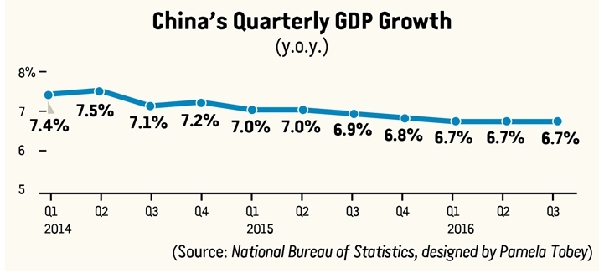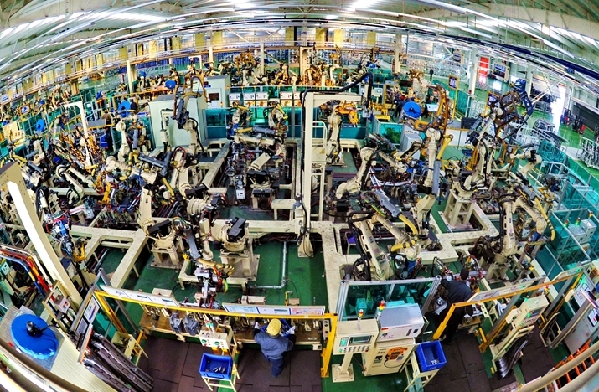On a smooth track
- By Zhang Liqun
 0 Comment(s)
0 Comment(s) Print
Print E-mail Beijing Review, January 10, 2017
E-mail Beijing Review, January 10, 2017
|
|
|
A welding workshop at Huanghua Sewon High-tech Vehicle Parts Co. Ltd. in Bohai New Zone, Cangzhou City, north China's Hebei Province, on December 14, 2016 (XINHUA) |
China's 2016 economic growth rate may stand slightly higher than 6.7 percent, the figure registered in the first nine months of the year. There are signs that the economy is bottoming out, as macroeconomic indicators in the first three quarters show that the economy has almost reached its nadir.
Growth engines
One piece of evidence is that domestic consumption continues to increase steadily by around 10 percent annually. China's retail sales of consumer goods grew 9.8 percent year on year from January to September, 0.1 percentage point higher than the rate in the first half of 2016.
As for employment data, the 10.67 million new jobs created in the first nine months have met the government's annual target ahead of schedule. Per-capita disposable income increased by 6.3 percent, closely trailing GDP growth. Given such robust employment and income figures, a stable increase in domestic spending is likely to continue throughout the year 2016, underpinning stable growth of the broader economy.
Robust infrastructure construction is another buoy for the economy. Investment in the sector, surging by 19.4 percent in the first three quarters from a year earlier, accounted for a quarter of the country's total investment, a sharp rise from the 17 percent in 2012. It is set to be a stabilizer for the nation's investment growth. Infrastructure construction is expected to shoot up in late 2016, with projects in the pipeline and under construction as well as ample capital.
In addition, the property market is expected to remain stable. The first three quarters of 2016 witnessed a 5.8-percent hike in housing investment. The market has been red hot in some cities since the first quarter. At present, local governments are correcting their housing markets with differentiated measures and restrictions put in place based on local conditions. The market frenzy is showing tentative signs of cooling in the near term, which will help to stabilize investment in the sector in 2017.
The ongoing urbanization project is the fundamental driving force for the property market. In recent years, the housing market boom has been sweeping first- and second-tier cities, which has had a ripple effect of shoring up markets in third- and fourth-tier cities. At the end of September 2016, space floor of unsold residential housing decreased by 4.32 million square meters from the housing inventory that peaked at the end of February 2016. The market is expected to hold steady in late 2016.
Finally, the decline in industrial profits has halted. Efforts to transform and upgrade China's industrial enterprises are paying off. In the first 10 months, profits of major industrial enterprises grew 8.6 percent year on year. Twenty-nine out of the 41 industrial sectors achieved year-on-year pick-ups in profits. It's early evidence that market demand is gradually picking up and therefore sales and trade are gaining momentum. It's clear evidence that more and more Chinese businesses are getting used to the current market environment.
To sum up, the drop of China's GDP growth has been checked, buoyed by increased spending, a better-than-expected job market, robust infrastructure construction, booming housing investment and bottoming-out industrial profits in the first nine to 10 months of 2016.
At present, China's economy is shifting from a high gear to a medium-to-high one. The change is different from fluctuations in an economic cycle. The shift involves not only the growth rate, but also growth models. A twin strategy of maintaining balance between demand and supply while integrating short- and long-term goals is required. The government should continue to push forward supply-side structural reform and to further consolidate the foundation for medium-to-high speed growth.
Proactive fiscal policies should play a more important role, and the government's investment capability should be further improved to bolster infrastructure investment, accelerate a new-type of urbanization and implement the Belt and Road Initiative. Monetary policy should remain prudent. And injection of liquidity should be cautiously managed to prevent financial crisis and support the real economy.
The new type of urbanization should be accelerated by developing promising second-tier cities and building several urban agglomerations with first-tier cities at their core.
Fundamental economic mechanisms should be optimized to create open, orderly and competitive markets. Credit reporting systems, for both individuals and legal entities, should be optimized as soon as possible. Clear lines should be drawn between the government and the market to lay bear their respective responsibilities.
People's livelihoods should be safeguarded. Overall plans should be introduced to cope with existing and urgent problems related to people's livelihoods and to meet the long-term target of building a well-developed social security system.

A bigger picture
Taken as a whole, the global economy will remain subdued and unstable in 2017.
Uncertainties remain about the United States' path to economic recovery, although both U.S. business investment and employment are on the rise. A huge income gap, worse-than-expected consumption growth, rising protectionist sentiment as well as surging populism weigh on the U.S. economy. In addition, the coming presidential shift will continue to blur the outlook for U.S. economic growth.
The Brexit referendum in June 2016, which triggered doubts about the commercial and financial ties between the UK and the European Union, will take a toll on investment and employment in Europe. What's worse, the issue of immigration fuels nationalist sentiment in Europe, which further hampers structural reform. Hence, the prospects for the European economy are fragile and full of uncertainty.
Growth in Japan is still dogged by yen appreciation and deflation.
The recovery of emerging markets and developing economies, such as China, generally outpaces that of advanced economies. But their weak economic bases give rise to uncertainties in their growth.
In addition, an anti-globalization trend is on the rise throughout the world. And, calls for trade protectionism and barriers are shooting up, which will negatively affect China's exports in 2017. However, the exports are projected to level off given that measures to prompt exports will take effect and product competitiveness will be improved by industrial transformation and upgrade in the coming year.
Investment growth in China is predicted to move within a tiny range and be no less than that of 2016.
First of all, major projects, related to urbanization plans and the Belt and Road Initiative (Silk Road Economic Belt and 21st-Century Maritime Silk Road), have been well-prepared. Funding models including public-private partnerships and issuance of local government debt have proved to be feasible. Therefore, infrastructure construction will remain robust.
Second, the real estate market will be gradually optimized by China's new type of urbanization, further propping up property demand. Generally, housing investment will remain unchanged, with rebounding sales, shrinking inventory and relatively sufficient funds invested in the sector.
Booming investment in infrastructure and real estate has put a brake on the decline of manufacturing investment in 2016, and the sector is expected to resume growth in 2017.
Improving people's livelihoods will be the Central Government's top priority in 2017. Steady economic growth will shore up the employment rate and per-capita income, therefore lifting domestic spending to help prompt growth.
In conclusion, China's economy in 2017 will increase at an even pace, not lower than that of 2016.






